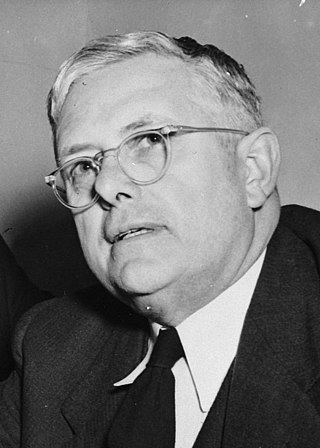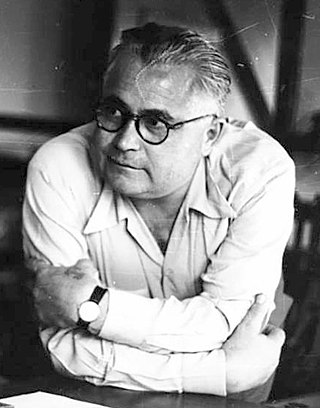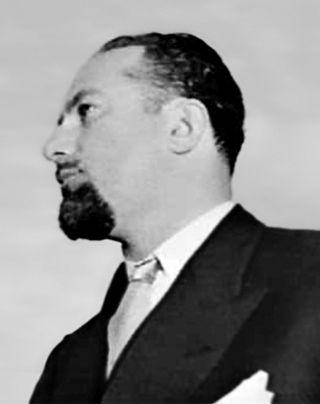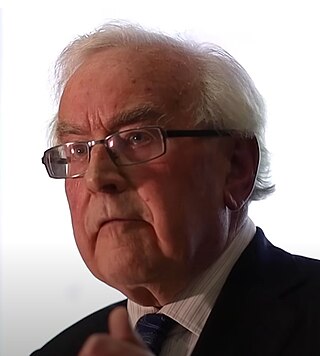The Australian Security Intelligence Organisation is Australia's national security agency responsible for the protection of the country and its citizens from espionage, sabotage, acts of foreign interference, politically motivated violence, attacks on the Australian defence system, and terrorism. ASIO is part of the Australian Intelligence Community and is comparable to the American FBI and the British MI5.

Herbert Vere Evatt, was an Australian politician and judge. He served as a judge of the High Court of Australia from 1930 to 1940, Attorney-General and Minister for External Affairs from 1941 to 1949, and leader of the Australian Labor Party (ALP) and Leader of the Opposition from 1951 to 1960. Evatt is considered one of Australia's most prominent public intellectuals of the twentieth century.

The Petrov Affair was a Cold War spy incident in Australia, concerning the defection of Vladimir Petrov, a KGB officer, from the Soviet embassy in Canberra in 1954. The defection led to a Royal Commission and the resulting controversy contributed to the Australian Labor Party split of 1955.

Vladimir Mikhaylovich Petrov was a member of the Soviet Union's clandestine services who became famous in 1954 for his defection to Australia.

Evdokia Alexeyevna Petrova was a Soviet spy in Australia in the 1950s. She was the wife of Vladimir Petrov, and came to prominence with him during the Petrov Affair.
Michael Rayner Thwaites, AO was an Australian academic, poet, and intelligence officer.

Sir Geoffrey Sandford Reed, KC was a justice of the Supreme Court of South Australia and the first Director-General of Security and head of the Australian Security Intelligence Organisation (ASIO).

The 1954 Australian federal election were held in Australia on 29 May 1954. All 121 seats in the House of Representatives were up for election, but no Senate election took place. The incumbent Liberal–Country coalition led by Prime Minister Robert Menzies defeated the opposition Labor Party led by H. V. Evatt, despite losing the two-party preferred vote. Although the ALP won the two-party preferred vote, six Coalition seats were uncontested compared to one ALP seat. The Psephos blog makes clear that if all seats had been contested, the Coalition would have recorded a higher primary vote than the ALP and possibly also a higher two-party preferred vote.

Foreign relations date back to 1807, when the Russian warship Neva arrived in Sydney as part of its circumnavigation of the globe. Consular relations between Australia and the Russian Empire were established in 1857. Diplomatic relations between Australia and the Soviet Union were established in 1942, and the first Australian embassy opened in 1943. Due to the 2022 Russian invasion of Ukraine, relations became very tense after Australia imposed sanctions against Russia. Russia placed Australia on a list of "unfriendly countries", along with Taiwan, South Korea, Japan, Singapore, the United States, European Union members, NATO members, Canada, New Zealand, Switzerland, Micronesia and Ukraine.

The Embassy of Australia in Moscow is the diplomatic mission of Australia to the Russian Federation. The current head of post and Ambassador of Australia to the Russian Federation is Graeme Meehan. The embassy serves as the diplomatic mission for Australia to the Russian Federation, Armenia, Belarus, Kazakhstan, Kyrgyzstan, Tajikistan, Turkmenistan and Uzbekistan. The chancery is located at 10A/2 Podkolokolny Lane in the Tagansky District of Moscow.

Brigadier Sir Charles Chambers Fowell Spry was an Australian soldier and public servant. From 1950 to 1970 he was the second Director-General of Security, the head of the Australian Security Intelligence Organisation (ASIO).

Michael Bialoguski was a Polish-Australian medical practitioner, musician and intelligence agent, who played a significant part in the 1954 Petrov Affair.
Ian Frank George Milner was a New Zealand Rhodes Scholar at New College, Oxford who had attended Waitaki Boys' High School. He was then a political scientist, a civil servant with the Australian Department of External Affairs in Canberra and with the United Nations in New York, and from the early 1950s a professor of English at Charles University in Prague where he became the friend and translator into English of the eminent Czech poet, Miroslav Holub.

Ric Throssell was an Australian diplomat and author whose writings included novels, plays, film and television scripts, and memoirs. For most of his professional life as a diplomat his career was dogged by unproven allegations that he either leaked classified information to his mother, the writer and communist Katharine Susannah Prichard, or was himself a spy for the Soviet Union.
Peter Robert Woolnough Barbour was an Australian intelligence officer and diplomat. He was also the Director-General of Security leading the Australian Security Intelligence Organisation (ASIO) from 1970 to 1975.
Walter Seddon Clayton was a key organiser of the Communist Party of Australia (CPA) in the 1930s and 1940s and suspected of being the Australian-based Soviet spymaster code-named 'KLOD', although the Australian Security Intelligence Organisation (ASIO) and Britains' MI5 were not able to provide any conclusive evidence of this for fear of tipping off the Soviets that their cable traffic was being deciphered and read by Western intelligence agencies.

Paul Dibb AM is an English-born Australian strategist, academic and former defence intelligence official. He is currently emeritus professor of strategic studies at the Strategic and Defence Studies Centre that is part of the Australian National University.

George Ronald Richards was a British-born Australian police officer and intelligence operative. In 1953 he was closely involved in Operation Cabin 12, arranging the defection of Vladimir Petrov from the Soviet Union to Australia. In 1954, he was appointed Deputy Director-General of the Australian Security Intelligence Organisation (ASIO), roughly equivalent to the FBI and MI5. He received the Order of the British Empire in 1957.

Arnott Street Railway Bridge was a small, isolated railway bridge in Canberra, most famously used by soviet agent Vladimir Petrov in 1954 as a dead drop location for the Australian Security Intelligence Organisation (ASIO). The bridge was used as part of the Bombala railway line before it was demolished in 2018.

Coral Mary Bell was an Australian academic, who wrote extensively about international relations and power politics.















